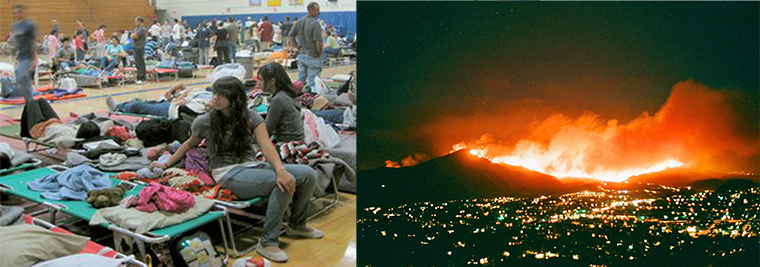




San Diego Gas & Electric is making a last stand for a plan to recover uninsured costs for the 2007 wildfires from utility customers, appealing to individual state utilities commissioners in several face-to-face meetings this month.
What would utility investors pay?
Two competing draft decisions would either reject outright SDG&E’s proposal for streamlining cost recovery for recent and future fires or prohibit the utility from including costs, including legal expenses, from the 2007 fires.
Instead, the authors suggest, SDG&E should request approval to bill customers using long- standing procedures for major events seen as beyond the control of utility management.
SDG&E is asserting that either draft decision, without amendments, would deprive the utility of a fair opportunity to recover costs for conducting business in a fire-prone region, as guaranteed under California law.
A vote by the California Public Utilities Commission is scheduled for Thursday but may be delayed. The vote could help determine who ultimately is responsible — utility customers or shareholders — for 2007 wildfire costs currently estimated at $369 million, with roughly 1,750 court claims against the utility still unresolved.
Consumer advocates are concerned that the utility’s request would undermine the vetting process that shields customers from unreasonable costs.
Timothy Simon, the commissioner overseeing the proceeding, sought to allay those concerns during a wide-ranging discussion Monday in San Francisco involving the commission’s five members, SDG&E representatives and critics of the utility’s plan.
“I think that the notion that there is no review … or that it is some type of blank check is clearly unwarranted,” said Simon, who indicated revisions to his draft decision were likely before a full commission vote.
Triggered in large part by San Diego Gas & Electric power lines, three wildfires in October 2007 destroyed more than 1,300 homes and killed two people. The final bill is coming due five years after SDG&E exhausted $1.9 billion in insurance and counterclaims against contractors and a cable company linked to the fires’ ignition.
SDG&E has pressed its cases with individual members of the San Francisco-based commission. Many critics of the SDG&E proposal have taken advantage of their own right to equal time with commissioners, who are appointed by the current and previous state governor.
Commissioner Simon has embraced in principle SDG&E’s proposal for utility customers to pick up 90 percent of uninsured fire costs and legal expenses through the creation of a wildfire expense balancing account. Utility investors would pay the first $10 million and 10 percent thereafter.
But the standard would not apply to the 2007 fires, and utility customers could not be charged without a court or commission finding that the utility was not at fault, under Simon’s draft decision. SDG&E has provided its own edition of a draft ruling to commissioners for guidance.
Two of California’s four investor-owned utilities — SDG&E and Southern California Gas, both subsidiaries of Sempra Energy — are parties to the application. Southern California Edison and Pacific Gas and Electric dropped out of the proceeding.
Administrative Law Judge Maribeth Bushey has recommended rejecting the SDG&E plan outright, arguing that it would thrust unlimited liability for damages onto utility customers while undermining incentives to reduce wildfire risks.
Two state investigations found that SDG&E lines, and to a lesser degree Cox Communications equipment, caused the 2007 fires, which spread quickly under dry conditions and gusting Santa Ana winds. Cox has since paid SDG&E $444 million under a settlement agreement.
San Diego Gas & Electric denies it was ever at fault, but it apologized previously for obstructing investigators looking into the root causes. In 2009, SDG&E agreed to pay $14.4 million to the state’s general fund to settle accusations that shoddy maintenance led to the blazes.